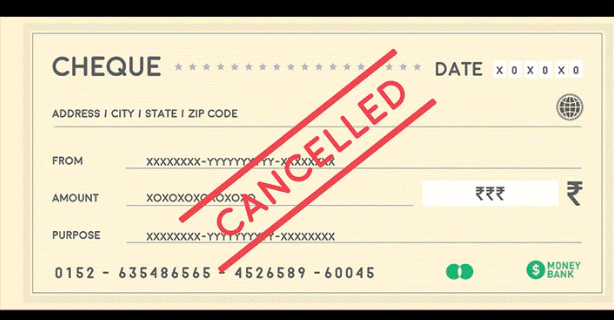A cancelled cheque is often requested by banks, financial institutions, or employers for various purposes such as verifying your account details, setting up electronic funds transfers, or direct deposits.
Additionally, when opting for No Cost EMI, many retailers and finance providers may request a cancelled cheque to facilitate the EMI setup process. While writing a cancelled cheque is a straightforward process, it’s important to do it correctly to ensure your banking information is properly communicated. This step-by-step guide will walk you through how to write a cancelled cheque correctly.
What is a Cancelled Cheque?
A cancelled cheque is identified by two parallel lines drawn across it, with the word “cancelled” inscribed within this boundary.This type of cheque is not meant for transactions but is used to provide proof of your bank account details, including the account number and the bank’s branch information.
Why You Might Need a Cancelled Cheque
There are several instances where you might need to provide a cancelled cheque:
- Setting Up Direct Deposit: Employers often require a cancelled cheque to set up direct deposit of your salary.
- Automated Electronic Transfers: Banks might need a cancelled cheque to link your account for services such as loan repayments or recurring bill payments.
- KYC (Know Your Customer) Processes: Financial institutions may ask for a cancelled cheque to verify your bank details during account opening or for investment purposes.
How to Write a Cancelled Cheque Correctly
Learning how to write a cancelled cheque correctly is essential for ensuring your banking details are verified securely. By following simple steps, you can provide necessary information without risking unauthorized transactions.
Step 1: Start with a Blank Cheque
Begin with a blank cheque from your cheque book. Ensure it is from the correct bank account you intend to provide information for.
Step 2: Draw Two Parallel Lines
Using a pen, draw two parallel diagonal lines across the cheque. This helps to ensure that the cheque cannot be used for any transactions.
Step 3: Write “Cancelled” Between the Lines
Between the two lines, write the word “Cancelled” in clear, legible letters. Make sure it is centered and not overlapping any critical information such as the account number or bank details.
Step 4: Do Not Sign the Cheque
It’s important to remember that a cancelled cheque should not be signed. Signing it could lead to potential misuse.
Step 5: Verify the Information
Ensure all the necessary details are visible and not obstructed. This includes:
- The cheque number
- The MICR code (Magnetic Ink Character Recognition) at the bottom
- Your bank account number
- The bank’s branch address and IFSC code (Indian Financial System Code) if applicable
Step 6: Safely Store the Cancelled Cheque
After writing a cancelled cheque, keep it in a secure place until you need to provide it. Do not hand it over to unauthorized individuals to prevent misuse of your banking information.
Common Mistakes to Avoid
Signing the Cheque
One of the most common mistakes is signing the cancelled cheque. Remember, you should not sign a cancelled cheque to avoid any risk of it being used for fraudulent purposes.
Obscuring Important Information
Ensure that when you draw lines or write “Cancelled”, you do not obscure any vital details like the MICR code or the account number.
Using a Pencil
Always use a pen to write a cancelled cheque. A pencil mark can be erased, posing a security risk.
When to Use an Alternative
In some cases, banks and institutions might accept a photocopy of your cheque instead of an actual cancelled cheque. However, it’s always best to check their specific requirements before providing a substitute.
Conclusion
Knowing how to write a cancelled cheque correctly is a simple yet essential skill for managing your banking affairs. By following the steps outlined above, you can ensure your bank details are accurately and safely communicated whenever required. Whether setting up a direct deposit, verifying account details for financial transactions, or fulfilling KYC requirements, a correctly written cancelled cheque serves as a reliable proof of your banking information.

